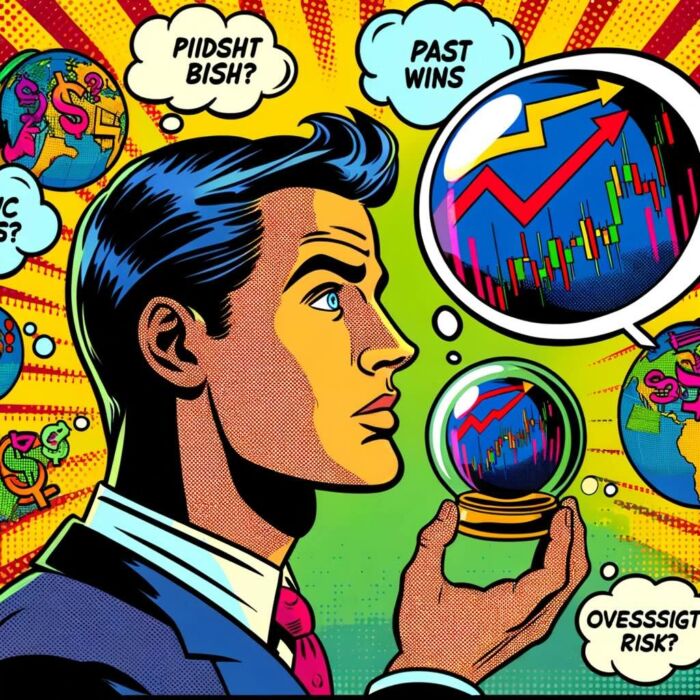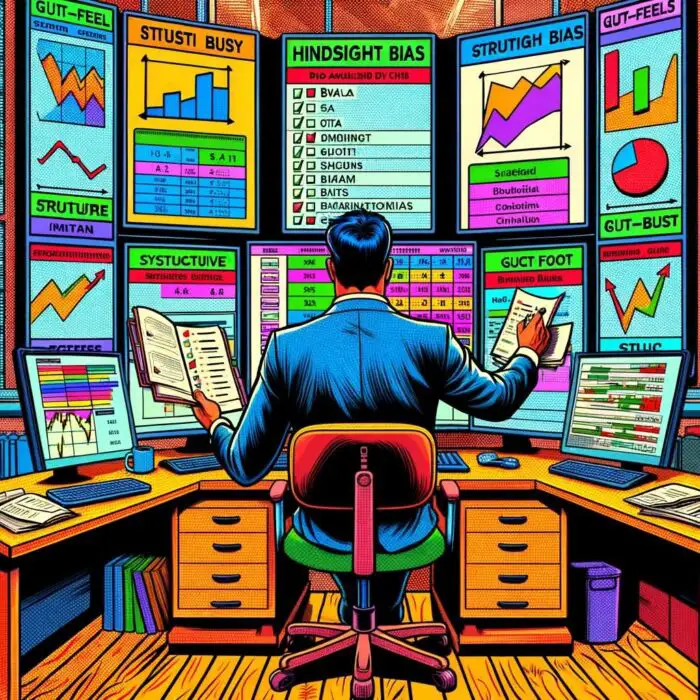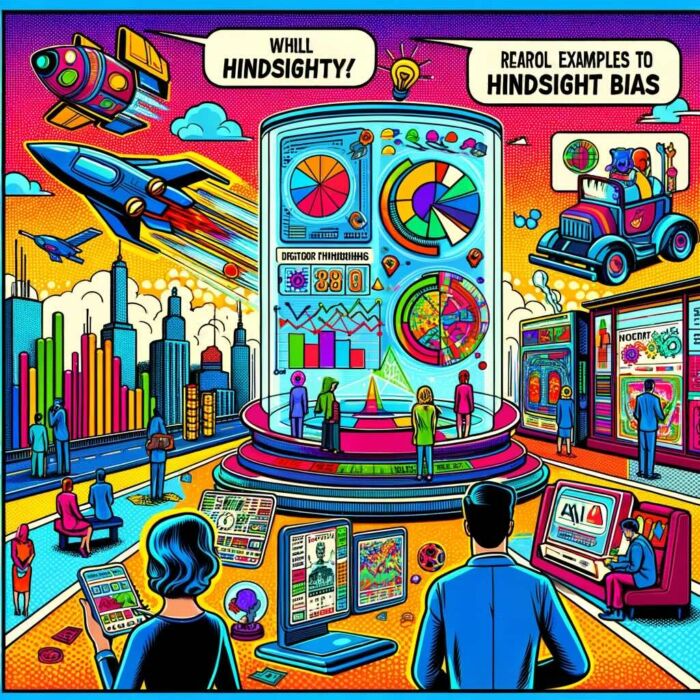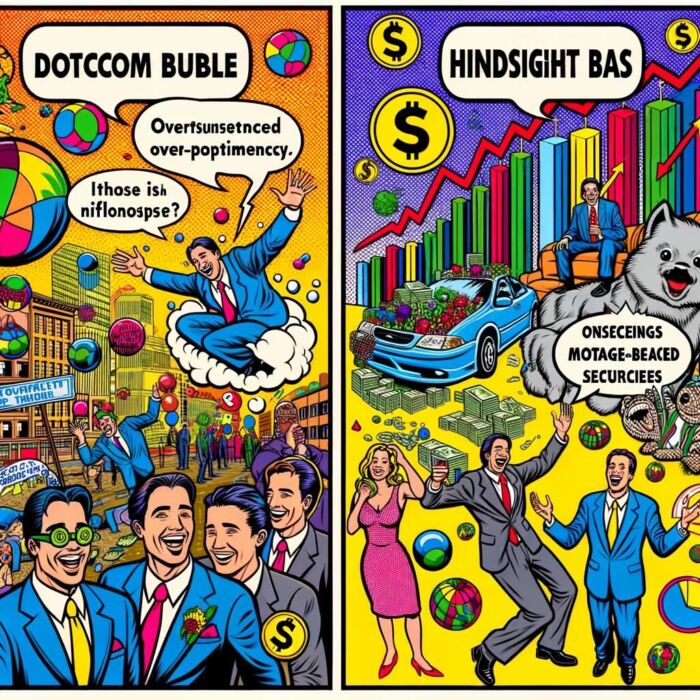Hello, investing enthusiasts and curious minds alike. Allow me to guide you on a journey into the labyrinth of investing biases, a journey that will provide you with new insights and tools to become a more informed investor. Our destination? The intriguing and often deceptive world of Hindsight Bias. But before we dive into the depths, let’s ensure we’re all on the same page about what this term means.

Definition of Hindsight Bias
Hindsight Bias, a psychological phenomenon often referred to as the “knew-it-all-along” effect, is the tendency for people to perceive past events as having been more predictable than they actually were before they took place. It’s like watching a thriller movie for the second time and feeling an inexplicable certainty about the plot twists; only, in our case, the plot is the unpredictable financial market, and the characters are the myriad of investment options at our disposal.

Overview of the Role of Hindsight Bias in Investing
Now, you might be wondering, “What does a psychological phenomenon like Hindsight Bias have to do with investing?” More than you might think! Just like how it can taint our perception of past events in general, Hindsight Bias can rear its head when we look at our investing histories too.
Consider this: an investor buys a stock, and it soars. Looking back, the investor feels that the stock’s success was inevitable, given the company’s strong quarterly earnings or its recent product breakthrough. In reality, dozens, if not hundreds, of factors could have led to a completely different outcome. But Hindsight Bias muddies these waters, fostering the illusion that success was guaranteed and promoting a potentially hazardous overconfidence in the investor’s decision-making abilities.

Importance of Recognizing and Overcoming Biases in Investment Decision Making
So why does understanding Hindsight Bias matter? Why not just shrug it off as another human quirk? Because left unchecked, it can have serious implications on an investor’s ability to make sound decisions. It can lead us to overestimate our predictive abilities, instilling a false sense of certainty in a landscape that is anything but. By recognizing and combating this bias, we open ourselves up to more objective evaluations of our investment decisions, both past and future.
It’s important to remember that while we cannot completely eliminate Hindsight Bias, being aware of its influence empowers us to challenge our assumptions, question our decision-making process, and ultimately make better, more informed investment decisions.
So, buckle up and prepare for a deep dive into understanding Hindsight Bias, its impact on our investing behavior, and the tools and techniques to keep it in check. After all, the first step to mastering the financial markets is mastering our own minds.

Understanding Hindsight Bias
Delving Deeper into the Concept of Hindsight Bias
In our quest to decipher Hindsight Bias, we must first dig deeper into its conceptual framework. At its core, Hindsight Bias manifests as an illusion that causes us to revise our memory of the past to fit the present. That is, we mold our recollection of our past predictions to align seamlessly with how events have actually unfolded, thus fooling ourselves into believing that we “knew it all along”.
Why is this problematic? Imagine the gambler who remembers all his wins vividly but conveniently forgets his losses, or the startup investor who only recalls the one unicorn in her portfolio, dismissing the nine others that failed. This selective alteration of memory can lead us to overestimate our decision-making abilities, creating a potentially dangerous foundation for future decisions.
Psychological Roots and Why it Occurs
The roots of Hindsight Bias burrow deep into the soil of our psyche, nourished by our innate need for predictability and control. The world is a complex and uncertain place, and our minds are wired to seek patterns, make connections, and establish cause-and-effect relationships even when none exist.
This bias is also stoked by our ego’s desire to avoid the uncomfortable sting of being wrong. It’s much more soothing to our self-image to believe that we foresaw an event, rather than admitting that we were taken by surprise or that our predictions were off mark.

Examples of Hindsight Bias in Everyday Life
Hindsight Bias isn’t exclusive to the realm of finance; it permeates all facets of our lives. Remember the last time your favorite team won a game and you thought, “I knew they would win!”? Or perhaps when you aced an exam and felt certain afterwards that you “knew it was easy”? These are classic examples of Hindsight Bias in action.
Even in the scientific community, which values objectivity above all, Hindsight Bias can creep in. For instance, once a discovery is made or a theory is proven, it can seem so obvious that people wonder why it wasn’t discovered or proven sooner. Such is the allure of Hindsight Bias that it can make the uncertain seem certain, the unpredictable predictable, and the surprising, well, not so surprising after all.
As we continue on our journey of understanding Hindsight Bias, remember this: acknowledging its presence in our lives is the first step towards countering its influence in our investment decisions. Stay tuned as we explore its impact on investing and share strategies for keeping it in check.
source: Scripbox on YouTube
The Impact of Hindsight Bias on Investment Decisions

How Hindsight Bias Can Affect Our Investment Decisions
As we venture further into the realm of Hindsight Bias, we must confront its influence on our investment decisions. Just as it paints a rosy picture of our past predictions, Hindsight Bias can subtly distort our future financial decisions. Armed with the belief that we ‘knew’ past market trends, we might develop a misplaced confidence in our ability to predict future trends. We might start to see patterns where none exist, fall into the trap of overtrading, or even take on more risk, all based on the illusion that we have a firm grasp of what lies ahead. It’s akin to navigating a misty mountain road with a foggy windshield – sure, we may make it through on sheer luck, but is that a risk worth taking?
The Dangers and Potential Pitfalls of Hindsight Bias in Investing
The fallout of unchecked Hindsight Bias in investing can be severe. As it inflates our self-perceived investing prowess, it simultaneously blinds us to the inherent uncertainties of the market and to the lessons we could learn from our past missteps. If we believe we ‘knew’ that a certain stock would rise or a specific market would crash, we risk ignoring the multitude of factors and sheer chance that also played a part. And in doing so, we lose out on opportunities to grow and learn as investors.
Furthermore, Hindsight Bias may deter us from seeking professional advice or using analytical tools, as it can foster a belief that our own intuition and past ‘predictions’ are superior. As a result, we may not only make poor investment decisions, but also repeat them, creating a vicious cycle that’s hard to break.

Real-World Examples Demonstrating Hindsight Bias in Financial Markets
Historical events in the financial world provide us with vivid illustrations of Hindsight Bias. Consider the dot-com bubble of the late 1990s and early 2000s. After the bubble burst, many investors claimed they had ‘known’ it was a bubble and that its burst was ‘inevitable. Yet, during the bubble, the same investors were swept up in the hype, neglecting basic investment principles and ignoring signs of overvaluation.
The Global Financial Crisis of 2008 offers another example. In retrospect, many asserted they ‘knew’ the housing market was in a bubble and that the aggressive lending practices were unsustainable. However, prior to the crash, very few voices raised these concerns, and even fewer acted upon them.
Remember, the journey to becoming a better investor isn’t about ‘knowing’ what will happen next. It’s about understanding the markets, managing risks, and learning from both our triumphs and missteps. As we explore ways to mitigate Hindsight Bias, keep in mind that the goal isn’t to predict the future, but to prepare for it.
source: Mollooly Asset Management on YouTube
Strategies to Mitigate Hindsight Bias in Investing

Recognizing and Overcoming Hindsight Bias
Now that we’ve recognized the specter of Hindsight Bias lurking in our investing decisions, how do we exorcise it? Well, firstly, it requires self-awareness. Regularly check your recollections of past predictions against recorded facts. Did you really predict that stock’s rise or did Hindsight Bias alter your memory? Did you truly foresee that market crash or is it a retroactive ‘knowledge’ that came after the fact? Honesty with oneself can be challenging, but it is the first step towards overcoming this bias.
Another practical technique is to maintain a decision journal. Record your investing decisions, the reasoning behind them, and the expected outcomes. As the future unfolds, compare your predictions with actual events. This helps in creating an unvarnished record of your past decisions, providing a reality check against Hindsight Bias.

Role of Structured Decision-Making Processes in Combating Bias
Structured decision-making processes can act as a bulwark against Hindsight Bias. How so? By reducing the role of ‘gut feel’ and intuition, and elevating the importance of systematic analysis and careful consideration.
For instance, instead of making impulsive trades based on a hunch or a remembered ‘trend’, you could set up a process wherein every trade must be justified based on a predefined set of criteria. This might include fundamental analysis, technical analysis, or other quantitative measures. Such a process not only encourages thoroughness but also reduces the chances of Hindsight Bias skewing your decision-making.
Objectivity and Data-Driven Investment Strategies
Lastly, cultivating objectivity and a data-driven approach can help tame the beast of Hindsight Bias. Instead of relying on memory (which we know can be distorted), base your decisions on hard data and rigorous analysis. Embrace the power of tools and technology that can provide objective insights and eliminate the human biases we are prone to.
Consider using robo-advisors or algorithmic trading systems, which use predefined rules and data analysis, removing human emotions and biases from the equation. But remember, these tools are not a substitute for understanding the markets and the investment process. They are aids to assist you in your journey, and you need to understand their workings and limitations.
As we embrace these strategies, we must remember that the objective is not to be right all the time – that’s an unattainable goal in investing. The aim is to make well-informed, reasoned decisions, learn from our mistakes, and continuously improve. After all, the pursuit of investing wisdom is a marathon, not a sprint!
source: Visual Knowledge on YouTube
Role of Technology in Combating Hindsight Bias

Use of Financial Modeling and AI in Decision Making
As we advance into the 21st century, technology has emerged as a powerful ally in our fight against Hindsight Bias. The increasingly sophisticated field of financial modeling and artificial intelligence (AI) has made substantial inroads into investment decision-making.
Financial modeling, for instance, can help investors forecast future market trends based on quantitative analysis, not just past performance or ‘gut feeling. These models can incorporate a multitude of variables and provide a more objective basis for investment decisions. Of course, while models are helpful, they are not infallible and still require informed human judgment.
Artificial Intelligence, particularly machine learning, can take this a step further. These systems can learn from vast amounts of data, recognize patterns, and make predictions without falling prey to the biases that humans are susceptible to. From creating personalized investment portfolios to identifying unique market opportunities, AI is proving to be an invaluable tool in objective, data-driven investing.
How Technology Can Help Create More Objective Investment Strategies
Technology can assist in the development of more objective investment strategies by providing real-time, accurate data, and analytics. Using technology, investors can access global financial markets, gain insights into complex financial products, and make informed decisions based on rigorous analysis rather than biased recollections.
Additionally, sophisticated software tools can aid in diversifying portfolios, minimizing risk, and optimizing returns. For example, robo-advisors, which employ algorithms to manage investments, can make unbiased decisions based on the investor’s risk profile and financial goals. By leveraging such tools, investors can mitigate the influence of Hindsight Bias and make more balanced, objective decisions.

Real-World Examples of Technology Helping to Mitigate Hindsight Bias
There are numerous real-world examples of technology aiding in the reduction of Hindsight Bias. Investment firms and hedge funds use complex algorithms and AI to make trading decisions, reducing the influence of individual biases.
Similarly, retail investors have access to numerous online tools and platforms that use AI to provide investment advice or automate trading. By relying on these unbiased, data-driven tools, investors are less likely to be swayed by Hindsight Bias.
Another interesting example is the emergence of prediction markets, where participants bet on the outcomes of future events. These markets often use AI and crowd wisdom to make predictions, eliminating individual biases, including Hindsight Bias.
The key takeaway is that while technology is a powerful tool, it is not a panacea. Investors should use it judiciously, while continuing to educate themselves, maintain a disciplined approach, and strive for constant improvement. After all, the most effective defense against Hindsight Bias is a well-informed, self-aware investor.
source: Next Level Life on YouTube
The Future of Behavioral Finance

Importance of Understanding Biases in Financial Decisions
As the field of behavioral finance matures, the importance of understanding cognitive biases in financial decision-making is becoming increasingly clear. The old-school assumption that investors always act rationally and have access to perfect information has been upended. In its place, a more nuanced view has emerged, recognizing that our decisions are influenced by a host of biases and emotional factors.
In this scenario, the ability to recognize, understand, and mitigate these biases can provide a significant edge. Whether you’re a day trader flipping stocks, a fund manager handling billions, or a retail investor planning for retirement, being aware of how biases like Hindsight Bias can influence your decisions is critical.
Understanding these biases can help investors avoid costly mistakes, make more informed decisions, and improve their financial outcomes. As such, the study and understanding of biases are likely to take center stage in the future of finance and investing.
The Evolving Role of Technology in Behavioral Finance
The intersection of technology and behavioral finance is an exciting development with enormous potential. As we’ve seen, technology can help combat biases like Hindsight Bias, providing more objective, data-driven tools for investment decision-making.
The role of technology in behavioral finance is set to evolve and grow in the coming years. Machine learning and AI can help analyze vast amounts of data and recognize patterns that human investors might miss. These tools can learn from past mistakes and successes, refining their models over time to improve predictions.
Moreover, technology can also help in disseminating knowledge about behavioral finance. Online platforms, digital courses, and interactive tools can make this knowledge accessible to a wide range of investors, democratizing the understanding of behavioral biases and their impact on our financial lives.

Challenges in Combating Biases like Hindsight Bias
Looking ahead, the battle against biases like Hindsight Bias is likely to intensify. As financial markets become more complex and intertwined, the cost of biases could become even more significant. At the same time, the rapid advancement of technology and AI provides hope that we can develop more sophisticated tools to mitigate these biases.
However, it’s essential to acknowledge the challenges. Technology itself is not immune to biases. AI and machine learning models are as good as the data they’re trained on, and if that data carries biases, the models too might reflect them. Hence, it’s crucial to recognize this and ensure that technology is used judiciously and ethically.
Moreover, while understanding biases is important, changing behavior is often hard. It requires constant effort, self-awareness, and discipline. Tools and knowledge can help, but ultimately, the onus is on us as investors to strive for objectivity and learn from our experiences.
In conclusion, the future of behavioral finance looks bright, filled with potential and challenges. As we embark on this journey, let’s keep our minds open, remain aware of our biases, and continue to strive for better, more informed decisions. After all, that’s what investing is all about!
source: SAMT AG Switzerland on YouTube
Case Studies
Examples of Successful Investors Who’ve Navigated Hindsight Bias
One of the most prominent investors who has successfully navigated the waters of Hindsight Bias is none other than Warren Buffett. His value investing philosophy, honed under the guidance of Benjamin Graham, is known for its focus on intrinsic value rather than market trends or past performance. This strategy allows him to objectively assess potential investments, mitigating the influence of Hindsight Bias.
Buffett often uses the analogy of “Mr. Market,” a hypothetical investor driven by panic and euphoria rather than rational thought. This approach helps him to separate his investment decisions from the market’s behavior and his past experiences, enabling him to avoid the pitfalls of Hindsight Bias.
Similarly, Ray Dalio, founder of Bridgewater Associates, relies on a principle-driven approach and employs a diversified portfolio to hedge against unexpected market movements. He recognizes that hindsight is not indicative of future outcomes, and therefore, builds systems and models that cater to a range of possibilities, not just those that have previously occurred.

Situations Where Hindsight Bias Led to Investment Missteps
On the flip side, there have been numerous situations where Hindsight Bias led to severe investment missteps. A striking example is the Dotcom Bubble in the late 1990s and early 2000s. Investors, fueled by the success of early internet companies, believed they could predict the market’s trajectory based on recent trends. However, this overconfidence, a manifestation of Hindsight Bias, led to massive overvaluations and ultimately a market crash that wiped out trillions of dollars in market value.
Another example is the 2008 financial crisis. Prior to the crisis, many investors believed that housing prices could only go up, given their historical performance. This Hindsight Bias led to risky investment decisions, such as the creation and purchase of mortgage-backed securities. When the housing market collapsed, these securities plummeted in value, triggering a global financial crisis.
These case studies underscore the importance of recognizing and overcoming Hindsight Bias in investing. By learning from the successes and failures of others, we can better equip ourselves to navigate the financial markets and make more informed investment decisions.

12-Question FAQ: Hindsight Bias—The Illusion of Predictability in Investment Decisions
1) What is hindsight bias in investing?
Hindsight bias is the “knew-it-all-along” effect—after outcomes are known, we perceive them as having been more predictable than they actually were, and we rewrite our memory of prior beliefs.
2) Why is hindsight bias dangerous for investors?
It breeds overconfidence, encourages excessive risk-taking and overtrading, and blocks learning from mistakes because outcomes are rationalized as obvious instead of analyzed.
3) How does hindsight bias distort performance reviews?
We selectively remember wins as “inevitable,” downplay luck, and forget contradictory evidence, producing inflated skill assessments and flawed future decisions.
4) What common market examples reveal hindsight bias?
Bubbles and busts (dot-com, housing/2008, meme stocks, energy spikes) often feel “obvious” only after the fact, even though few predicted timing or magnitude ex-ante.
5) How can I tell I’m slipping into hindsight bias?
Red flags: “Of course that was going to happen”; vague recollections of your thesis; ignoring alternative scenarios you once considered; attributing losses to “bad luck” and wins to “skill” only.
6) What’s a simple tool to fight it?
Keep a decision journal. Before trades, record thesis, alternatives, risks, base rates, price/valuation, and what would falsify the idea. Review later against what you actually wrote.
7) Which structured processes help most?
Pre-mortem: imagine the investment failed; list reasons.
Post-mortem: after outcomes, grade decision quality vs. process, not outcome.
Checklists: standardized criteria reduce memory drift.
Base-rate/Outside view: anchor on historical statistics, not stories.
8) How do forecasting techniques reduce hindsight bias?
Use probabilistic forecasts (with %-odds and time windows), track a Brier score, and archive forecasts. Numbers plus scoring prevent retroactive certainty.
9) Can technology help?
Yes—analytics dashboards, backtests with out-of-sample periods, portfolio attribution, and rules-based/risk-budgeting systems (or robo-advisors) create objective records that are hard to rewrite.
10) What team practices counteract it?
Devil’s-advocate roles, red-team reviews, written investment memos, pre-trade checklists, and requiring quantified scenarios (bull/base/bear) with triggers for exit/resize.
11) How should I review big wins and losses to learn?
For both, separate process vs. outcome: Was the thesis right for the right reasons? What was luck? Would you make the same decision again under identical information?
12) What’s the bottom line for everyday investors?
Accept uncertainty, document decisions, think in probabilities, and judge yourself on process quality. You can’t eliminate hindsight bias—but you can contain it.
Conclusion
Hindsight Bias and Its Influence on Investment Decisions
We embarked on this exploration to better understand Hindsight Bias and how it can shape our investment decisions. We delved into the core of this cognitive bias, tracing its psychological roots, and discovering how it can lead us to falsely believe that we could predict outcomes based on past events.
We saw how Hindsight Bias can affect our investment decisions, leading us to become overconfident, overlook risks, and fail to prepare for the unpredictable nature of financial markets. These mistakes can be costly, as we’ve learned from real-world examples and instances when Hindsight Bias has led investors astray.

Encouragement for Continuous Learning and Self-awareness in Investing
But, as with any journey, reaching the destination is only the beginning. The knowledge gained must be applied, and that is where the real challenge lies. Recognizing Hindsight Bias is the first step, but overcoming it requires continuous effort, learning, and self-awareness.
As investors, we must strive to keep our biases in check, constantly question our assumptions, and not be swayed by past events into thinking we can predict the future. Investing is as much a test of character as it is of intelligence. It requires us to be disciplined, patient, and humble, acknowledging what we don’t know, and learning from our mistakes.
Role of Behavioral Finance in Shaping Successful Investors
In the grand tapestry of investing, understanding behavioral finance and cognitive biases like Hindsight Bias is akin to understanding the threads that make up the fabric. It enables us to see the whole picture more clearly and weave better investment strategies.
Our exploration of Hindsight Bias is but one thread in this vast tapestry. There are other biases to discover and understand, each with its unique influence on our investment decisions. As we continue this journey into the depths of behavioral finance, let’s remember that the ultimate goal is not just to become better investors, but to become better decision-makers, better learners, and ultimately, better versions of ourselves.
So, let’s keep exploring, questioning, and learning. After all, the journey is the destination. Happy investing!
Important Information
Comprehensive Investment Disclaimer:
All content provided on this website (including but not limited to portfolio ideas, fund analyses, investment strategies, commentary on market conditions, and discussions regarding leverage) is strictly for educational, informational, and illustrative purposes only. The information does not constitute financial, investment, tax, accounting, or legal advice. Opinions, strategies, and ideas presented herein represent personal perspectives, are based on independent research and publicly available information, and do not necessarily reflect the views or official positions of any third-party organizations, institutions, or affiliates.
Investing in financial markets inherently carries substantial risks, including but not limited to market volatility, economic uncertainties, geopolitical developments, and liquidity risks. You must be fully aware that there is always the potential for partial or total loss of your principal investment. Additionally, the use of leverage or leveraged financial products significantly increases risk exposure by amplifying both potential gains and potential losses, and thus is not appropriate or advisable for all investors. Using leverage may result in losing more than your initial invested capital, incurring margin calls, experiencing substantial interest costs, or suffering severe financial distress.
Past performance indicators, including historical data, backtesting results, and hypothetical scenarios, should never be viewed as guarantees or reliable predictions of future performance. Any examples provided are purely hypothetical and intended only for illustration purposes. Performance benchmarks, such as market indexes mentioned on this site, are theoretical and are not directly investable. While diligent efforts are made to provide accurate and current information, “Picture Perfect Portfolios” does not warrant, represent, or guarantee the accuracy, completeness, or timeliness of any information provided. Errors, inaccuracies, or outdated information may exist.
Users of this website are strongly encouraged to independently verify all information, conduct comprehensive research and due diligence, and engage with qualified financial, investment, tax, or legal professionals before making any investment or financial decisions. The responsibility for making informed investment decisions rests entirely with the individual. “Picture Perfect Portfolios” explicitly disclaims all liability for any direct, indirect, incidental, special, consequential, or other losses or damages incurred, financial or otherwise, arising out of reliance upon, or use of, any content or information presented on this website.
By accessing, reading, and utilizing the content on this website, you expressly acknowledge, understand, accept, and agree to abide by these terms and conditions. Please consult the full and detailed disclaimer available elsewhere on this website for further clarification and additional important disclosures. Read the complete disclaimer here.





